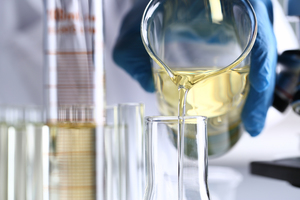

|
Edward Lowton
Editor |


|
| Home> | Plant, Process & Control | >Lubricants | >Choosing sustainable lubricants without compromising on performance |
Choosing sustainable lubricants without compromising on performance
26 August 2022
With sustainability rightly high on the global agenda, the manufacturing industry has a vital role to play in delivering a clean future. Reflecting the central role of industrial lubricants in machining operations, it's key for manufacturers to know how to choose sustainable metalworking fluids, while doing so makes not only environmental but also financial sense, says Songul Facey

GIVEN THE essential and vital role of industrial lubricants in machining operations, choosing more environmentally-friendly metalworking fluids (MWFs) can be an important step towards creating a more sustainable full product lifecycle.
Understandably, there may be concerns in some quarters around whether the pursuit of sustainability goals will result in productivity being sacrificed. Thankfully for manufacturers – and the planet – the answer is no: sustainable MWF products are coming to market that are capable of delivering superior performance to meet today’s requirements, reducing the use of harmful chemicals while increasing process efficiency.
The key for manufacturers is knowing how to choose products that contain the least possible hazardous components and have a comparatively lower toxicity; understanding why using more sustainable MWFs makes commercial as well as environmental sense; and recognising the continued importance of good system design and maintenance.
Make sustainable choices and avoid pictograms
When seeking to identify the optimum product, look closely at the base oils and additives that the product contains and assess whether, and to what extent, these ingredients could be harmful to the health and safety of workers handling them or working nearby, and to the wider environment.
To put it simply, manufacturers should look specifically for products that do not have any precautionary statements or hazard pictograms, which will easily be seen on the product packaging label and Safety Data Sheet..
And as a general rule, avoid anything that contains nitrites, sodium nitrate, alkanol amines, secondary amines, PAHs, PTBBA and chlorinated paraffin, phenols, boron or formaldehyde-releasing biocides. It’s also important to be sure that the biocide that is used complies with current regulations and is used in the right proportion. If it exceeds limits, there is a risk it could cause skin irritation or more severe dermatological problems among workers.
Flammability, resistance to evaporation and liability to microbiological formations occurring are key considerations too. Fire risk is particularly high in pure-cutting and solvent-containing products, although soluble lubricants are not risk-free either. Products with a high oil content tend to have a high incidence of water evaporation as well, and this can result in permanent health damage, increase consumption of lubricants and create grease and dirt in the workshop environment.
Petroleum-derived products also inherently have low resistance against the build-up of bacteria, fungi, or yeast that impair performance and can be hazardous to health. So it’s vital to choose a product with a higher flash point to minimise the fire hazard, that is less prone to evaporation, and that is oil-free and emulgator-free.
Water-based MWFs which lubricate using biopolymer technology, rather than emulsifiers or mineral oils, are a good example of the innovative new solutions now available to the industry that can help meet many of these important environmental, health and safety objectives.
As well as delivering clear benefits to human health and the environment, water-based lubricants are gaining manufacturers’ attention for their performance across faster machining speeds, exceptional load carrying capacity, quicker de-greasing (in some cases eliminating the need to de-grease altogether) and extension to tool lifetime.
Management and maintenance
But having chosen the right product, for maximum sustainability, following the correct usage procedures including maintaining the cleanliness of the machining coolant system and, importantly, the sump, is essential.
Depending on dilution levels, around 90-95% of the liquid sump is made up of water, with the quality of the water itself - which may contain dissolved minerals, organic matter or microorganisms that can impact health and safety and fluid performance – therefore as important as the choice of lubricant.
Having a precise water quality not only ensures emulsion stability, but also helps reduce fluid usage and waste, as well as reducing the risk of bacteria growth, corrosion and build-up of soap and residue.
The water should be clean, neutral (around pH 7) and ideally deionized, and fall within specific values for water hardness, chloride/nitrate content, bacteria, acidity and conductivity (and be re-tested regularly to measure these properties on an ongoing basis).
It is important to clean the system properly of dirt, soap and microbiological residues prior to using any soluble cutting fluids. Adding 1-3% system cleaner to the sump due to be changed while the machine is still operational will do the job, and in order for the system to be fully chemically purged, the cleaner must be in the system for for a minimum of 24 hours. Once the old sump is emptied and the lubricant and any debris has drained away, rinse the system with water (plus add 1% of new lubricant) multiple times. However, take care to avoid prolonged contact with the cleaning agent as this could cause skin irritation.
Sump stability is critical to the optimal performance of soluble MWFs, and that stability relies on a very specific mixing process, to create the right alkalinity/acidity and hydrophilic-lipophylic balance (HLB). Preferably use an automatic mixer operating at an ambient temperature of at least 10˚C, and monitor the bath for anomalies that may prove problematic by taking samples before and during use, as required by the Health and Safety Executive.
For example, the presence of substances like nitrogen, carbon, sulphur and phosphorous provide food for microorganisms that are detrimental to the quality of the emulsion. Be vigilant for other indicators like smell, pressure, temperature and flow rate to mitigate H&S risks and maximise efficiency.
Having all these parameters under control will help ensure operational quality, extend the lifetime of the sump and of the equipment, reduce waste and therefore limit the total cost-to-serve.
Water-based lubricants can have discernible impacts here, too. Manufacturers using such products have reported various benefits, including limited or no residue and fumes, oil-drain intervals significantly extended compared with conventional MWFs, and fluids needing to be changed less frequently.
System design is also fundamental to both sustainability and productivity, and with this in mind, the fluid reservoir tank size matters: too big or too small could both cause problems. If an oversized tank is used, poor aeration could cause more anaerobic microorganism activity, ineffective filtration, and deposit accumulation. If undersized, the lubricant could become overheated and the consequent water evaporation risks increasing the concentration. Adjusting the concentration level by topping up with water may trigger other issues, such as raising the water hardness and therefore chlorine content, with the attendant risk of corrosion. Other concerns with too-small tanks include fluid overflow, filter blockage and accelerated microorganism formation as the tramp oil rate increases.
Generally speaking, for general machining, the tank volume should be eight times larger than the pump flow rate, and for grinding operations, it should be 16 times bigger. In addition to a well-designed tank, sustainability will be achieved by using separation equipment including filtration, skimmers and coalescence to allow tramp oil to be cleaned so that fluid can be aired, and to enable local exhaust ventilation (LEV) to reduce health-damaging mist exposure from the MWF and improve air quality generally within workshops.
Performance for the long term
There is much to consider when it comes to MWF product selection, system design and maintenance, but the availability of more eco-friendly lubricants is a major leap forward in reducing the consumption of harmful toxic chemicals and the generation of hazardous fumes and waste in the manufacturing process.
These advances have also meant that more sustainable products can offer both environmental benefits, while maintaining optimal lubrication and performance of metalworking operations that all manufacturers need to see too, increasing machining speeds and enhancing component lifespans. For example, we have seen manufacturers able to cut coolant use by 35-40%, while creating a fume-free atmosphere and an excellent finish quality as well as extending tooling lifespans and reducing waste using our unique water-based MWF, FOLIA.
By selecting the right product, and ensuring effective machinery management and maintenance, efficiency and productivity can be maximised while simultaneously minimising environmental and health and safety risks. Viable solutions to the sustainability challenge are now available, with no need to compromise.
Songul Facey is technical sales manager (Metalworking) at TotalEnergies Marketing UK
For more information:
Tel: +33 (0)1 47444546
- The hidden costs of poor cleaning practices in industrial settings
- All round measurement solution
- Partnership to drive manufacturing innovation
- Cambridge Vacuum Engineering and Ford awarded funding to help speed electric motor production
- Power station fined after maintenance contractors injured
- The evolution of the valve island
- Frozen food firm gets taste of automation
- Applied intelligence key to efficient order fulfilment
- Breathe easy by specifying effective process filtration
- Gardner Denver to combine with Ingersoll Rand's industrial segment
- Lubricant support from online chat robot
- Lubricants, coolants and oil analysis
- Remote monitor for automatic lubrication systems
- Oil consumption cut
- Boosting the life of wire rope assets
- Lubrication equipment helps boost life of wire rope assets
- Interflon obtains ISO 21469 certification
- New developments and webshop discount
- Oil sampling: Benefits for preventative maintenance
- New corrosion preventative product launched



















